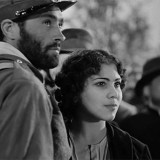As Italy celebrates its 150th year of unification (aka Risoregimento) this year, the Lincoln Film Society in New York chose to include this masterpiece by Alessandro Blasetti as part of their current festival: Open Roads: New Italian Cinema. I attended the screening and here are some of my impressions.
 Carmelo and Rosuzza his wife reunited against the backdrop of Italian Unification events:
Carmelo and Rosuzza his wife reunited against the backdrop of Italian Unification events:
individual vs. collective story lines.
Blasetti known for other historical epics, takes the opportunity to tell the story of Italy’s unification from a personal point of view of a Sicilian patriot named Carmelo (Giuseppe Gulino) on a mission to reach Garibaldi’s headquarters in Genoa and get his help to rescue Sicily from the occupying Spanish Bourbons and German mercenaries. On his way, Carmelo runs into various Italian characters representing different dialects and views regarding the boiling political climate.
The film predated the Neorealism genre that typically referred to as starting with Roberto Rossellini’s Roma, città aperta – Rome, Open City (1945). However, you can already see the genre’s key ingredients at play: usage of non-professional actors, movie shot on location, and description of social rough realities from a commoner point of view. Stylistically, this film is a far cry from Blasetti’s light-hearted 1954 Too Bad She’s Bad – Peccato che sia una Canaglia another precursor. This time, to Italian comedy (Commedia all’italiana) genre that formally started in 1958 with Mario Monicelli’s Big Deal on Madonna Street – I Soliti Ignoti. Indeed, an interesting and prescient work evolution.
The camera movement takes a role of inquisitive “embedded journalist-like” that follows the events either as a follower of Carmelo on his journey, but also as an objective spectator of historical events such as the panoramic battlefield scenes. I especially liked the opening scene where you can see a close up behind window bars and then zooming out to reveal the context of a Sicilian village under rough Bourbon occupation – a simple, yet a powerful way to express the state of imprisonment.
The screening followed by panel discussion with Professors Alexander Stille and Stefano Albertini, and director Mario Martone. Here are a few pointers I found interesting:
- Director Mario Martone: His film Noi Credevamo – We Believed (2010) was also shown in the festival and provided a modern view of Risoregimento through the personal story of three friends joining activist Giuseppe Mazzini’s political movement (Giovine Italia) and the impact on their lives afterwards. Overall, there are not many films about Italy’s unification. Blasetti in this film is rather unique by explicitly conveying the brutality and physical rough aspects of the period, woven through a personal story. This technique makes the historical event more believable as viewers have tangible “real-life handles” to relate to.
- Prof. Albertini: The film is not about Garibaldi, in fact we don’t see him much throughout the film; only the facial reactions of soldiers listening to him speak. With that, Blasetti’s message is simple: The Risoregimento (Italy’s unification) was not about the larger than life leaders, it was about real people, with real stories that despite their cultural differences joined forces. This message of unity is interesting to examine against today’s Italian politics, where the separatist Northern League party for example refuses to celebrate the unification and sees it as a waste of money. Another difference, back in the 60’s Italians did not celebrate unification with flags, as it was frowned upon as radical, whereas in this year’s celebrations flags were widely used.
- Prof. Stille: Blasetti’s technique keeping Garibaldi’s role at a distance and focusing more on people around him processing his impact, was similarly adapted in Francesco Rosi 1962’s Salvatore Giuliano, the famous Sicilian gangster. It forces the viewers to conjure their own opinion about the renowned personality based on the impact of their emotional projection. The film also carries a gender element as Carmelo’s officer commands him not to move from his post to see his wife he hasn’t seen a month just a few miles away. The officer gives as an example Garibaldi who his wife had died, while he was away to reinforce Carmelo’s obedience and patriotism.
So as you can see this masterpiece has dual historical values: getting you introduced to an important chapter in Italy’s history, while at the same time experiencing initial ingredients of Neorealism – a cardinal chapter in Italy’s and the world’s cinematic history.


Very energetic article, I liked that a lot.
Will there be a part 2?